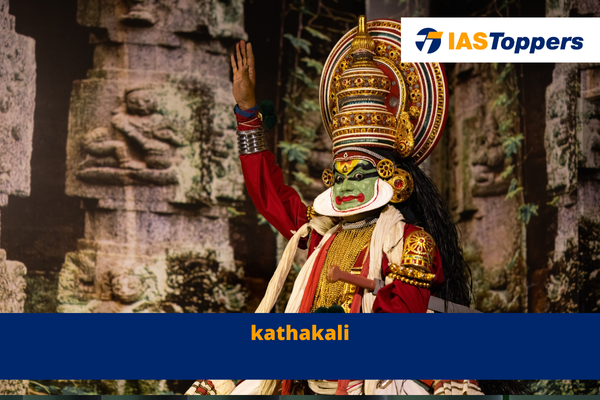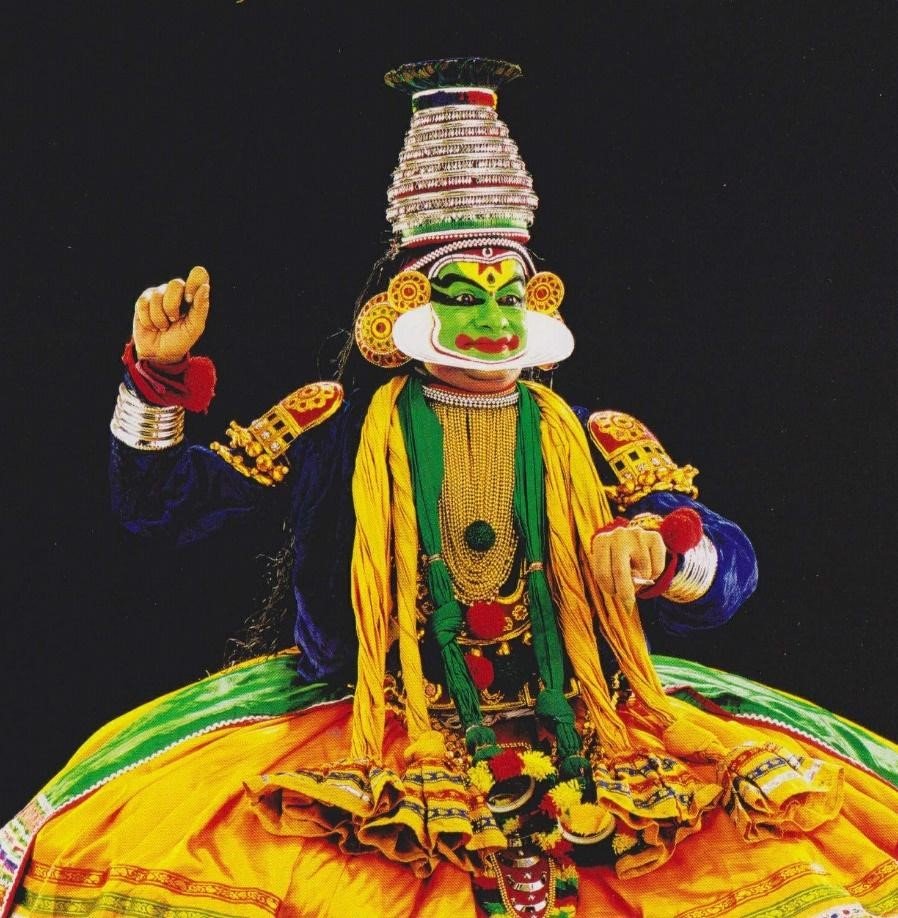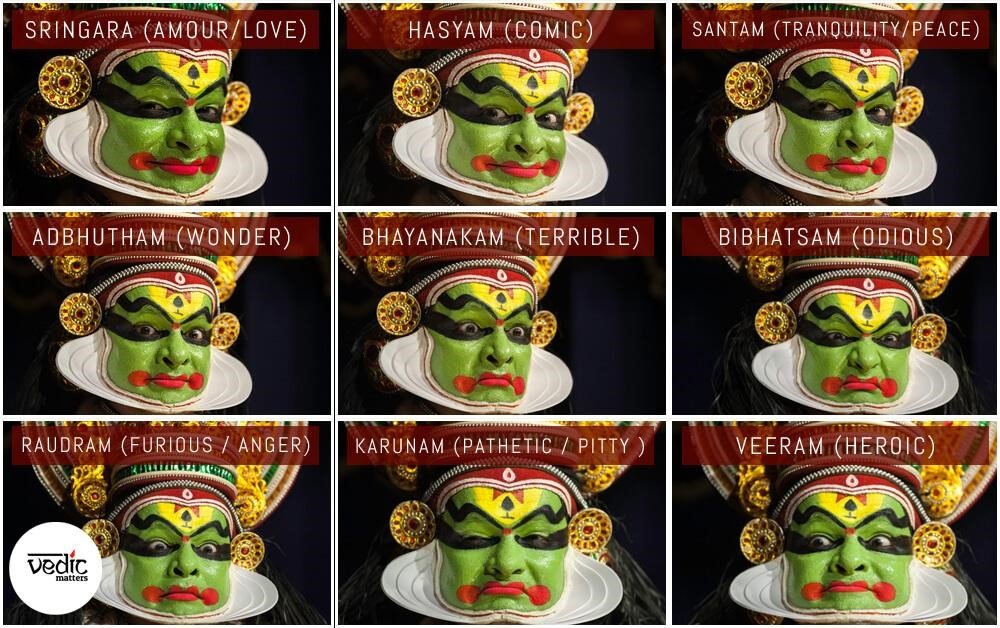Kathakali, originating from Kerala’s temples, is a classical Indian dance-drama renowned for its distinct facial makeup, elaborate costumes, and expressive eye movements. Combining elements of dance, drama, and music, it narrates stories from Indian epics and Puranas, emphasizing the interpretation of characters and emotions. Traditional Kathakali music incorporates instruments like Chenda, Maddalam, Chengila, among others, integral to the performance. In this article, you will know all the information about kathakali dance (kathakali nritya) such as Kathakali origin, how its performed, and key instruments used in Kathakali, all of which are important for GS Paper-1 Art & Culture of UPSC IAS Exam.
Table of Content
- What is Kathakali?
- Characteristics of Kathakali
- Music and Instruments of Kathakali
- Kathakali Costumes
- Conclusion
- FAQs on Kathakali
What is Kathakali
- The moniker ‘Kathakali’ came from two words: ‘Katha,’ denoting story, and ‘Kali,’ denoting drama.
- Originating from Kerala’s temples, Kathakali is a classical dance form typically performed by Malayalam speaking individuals.
- Kathakali has connections with Koodiyattam (an ancient Sanskrit theatre tradition) and numerous traditional martial arts performances.
- It evolved under the sponsorship of feudal lords, who used it to depict stories from the Ramayana and Mahabharata.
- Evidence of Kathakali can be seen in the 16th-century sculptures in Kerala’s temples and frescoes in the Mattancherry temple.
- Also known as Attakatha or “enacted story”, it was born out of earlier folk drama customs like Ramanattam, Chakiarkoothu and Krishnattam.
- However, with the collapse of feudal systems, Kathakali saw a decline until it was revitalized in the 1930s by Malayali poet V. N. Menon, with the support of Mukunda Raja.
Characteristics of Kathakali
- It’s also known as the ‘ballad of the east.’
- This dance incorporates elements of Indian martial arts and South Indian athletic traditions.
- Kathakali blends dance and drama, making it hard to separate the two.
- Kathakali performances traditionally feature only male artists but now, female artists are also seen.
- The stories it depicts usually revolve around the timeless battle between good and evil, drawing from the epic tales and the Puranas.
- Kathakali songs are sung in Manipravalam, a mix of Malayalam and Sanskrit.
- Music is an integral part of Kathakali, providing depth to the performance.
- A key aspect of Kathakali is the use of gestures and face painting.
- It’s notable for its expression of ‘rasas‘ (emotions) through eye and eyebrow movements.
- 9 significant facial expressions, known as ‘Navarasas,’ are shown in the kathakali dance through 24 kathakali mudras.
- It uses four aspects of abhinaya – angika, aharya, vachika, satvika and the nritta, nritya and natya aspects are combined perfectly.
- Dancers use predefined hastamudras and facial expressions to mirror the verses (padams) being sung.
- Balarama Bharatam and Hastalakshana Deepika provide the textual foundation for Kathakali.
- Kathakali focuses on various characters, including gods, saints, animals, and demon, which are broadly classified into satvika (Krishna and Rama), rajasika (warriors and scholars), and tamasika types of characters from the ancient Samkhya school of Hindu philosophy.
- Characters are also classified into distinct categories like pacha, kathi, thadi, kari, or minukku (kathakali kari vesham).
- Performances typically take place in open-air theatres covered with rough mats, or within temple premises, with the green trees of Kerala as a backdrop. A brass lamp serves as lighting.
- It starts with the kelikottu, which draws the audience’s attention, followed by a devotional piece called todayam. This is followed by purappadu, a pure nritta piece. The performance concludes with Tiranokku, marking the entrance of all characters except the pacha or minukku, after which the chosen play or scene begins.
- The start and end of a Kathakali performance are signalled by the arrival of dawn and the continuous sound of drums, chhenda, and maddala.
- Kathakali symbolizes the element of sky or ether.
- Notable exponents of Kathakali include Guru Kunchu Kurup, Gopi Nath, Kottakal Sivaraman, and Rita Ganguly, among others.
Music and Instruments of Kathakali
- Kathakali music is based on the traditional Sopana Sangeet of Kerala, which is said to be the ritual singing of the Ashtapadis on the stairway leading to the holy sanctum.
- Currently, Kathakali music also incorporates Carnatic ragas, the selection of which aligns with the bhava, rasa, and dance patterns (nritta and natya).
- The traditional orchestra comprises instruments such as Chenda, Maddalam, Chengila, Ilathalam, Idakka, and Shankhu, also used in other traditional Kerala performing arts.
Kathakali Costumes
Below are the key features of kathakali costumes and dress:
- Kathakali uses facial makeup giving an impression of a mask and headgear, with each colour signifying a different attribute. However, Props are rarely used in it.
Kathakali follows seven basic makeup codes:
- Green (Pacca), with coral red lips, represents virtue, divinity, and nobility.
- Red patches beside the nose are a symbol of royalty.
- Black (kari) denotes wickedness and evil, used for hunters, forest inhabitants, and demonesses.
- Yellow (Minukku) is utilized for women and saints.
- A white beard (Vella Thadi) is used to depict a divine or virtuous character.
- Red (Tati) makeup is used for evil characters like Ravana
- Teppu makeup is used for Special characters like Jatayu and Garuda
- Payuppu (ripe), and
- Katti (knife)
Conclusion
Kathakali art is an amalgamation of dance, drama, and music. The Kathakali characters, influenced by the Samkhya school of Hindu philosophy, bring to life gods, saints, animals, and demons through makeup, costumes, and expressive gestures. The rich history of Kathakali art along with the perfect blend of nritta, nritya, and natya elements have ensured its survival and relevance despite societal changes.
Ref: Source-1
| Other Articles in History & Culture | |
| Kharosthi Script and Gupta Script | Guru Nanak |
| Prehistoric Rock Paintings in India | Chalukya Dynasty |
| Magadha Empire | Ashoka’s Dhamma |
FAQs (Frequently Asked Questions)
What is Brahmi Script?
Brahmiis an alpha-syllabic writing system used in the Indian subcontinent and Central Asia.
What is Kharosthi Script?
Kharosthiis an ancient script utilized in the ancient Gandhara region (present-day Afghanistan and Pakistan) to write Gandhari Prakrit and Sanskrit.
What is Vatteluttu Script?
Vatteluttuis one of the three primary alphabet systems developed by Tamil people for writing their Tamil Script until the 9th century.
Which script of ancient India are written from right to left?
Kharosthi Script is predominantly written from right to left but it may also be written left to right.





